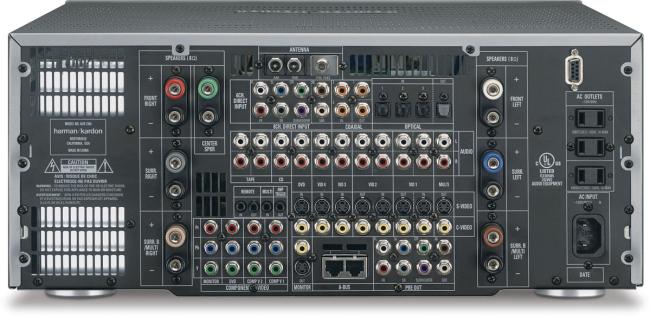Harman/Kardon AVR 7300 7.1 A/V Receiver August, 2005 Ross Jones
|
Click on the photo above to see a larger version. |
|
Specifications:
● Codecs: DD, DD-EX, Pro Logic IIx, DTS,
Harman/Kardon |
Introduction

Harman/Kardon's fine AVR 630 receiver (reviewed HERE) was still in my equipment rack when the mother of all HK receivers, the AVR 7300, arrived at my door. At $2,399 list price, the AVR 7300 costs considerably less than competitors' top-of-the-line offerings, but it was still nearly twice the price of the AVR 630 (now replaced by the AVR 635). I was curious to find out what the venerable A/V company had put into its flagship product.
The Design
At first glance, the AVR 7300 shares many of the attributes with the AVR 630. In fact, visually, the products are almost identical (particularly from the front). The AVR 7300 is 1 inch taller than the AVR 630, and 3 1/2 inches deeper (which made rack mounting a little challenging).
The 7300 weighs in at 55 pounds (14 pounds heavier than the AVR 630), and while that doesn't seem particularly heavy in the abstract, I realized that it is as much as my daughter weighs (and I wouldn't try squeezing her into a 19" wide rack space).
You don't need to be a rocket scientist to understand the weight difference. The AVR 630 is rated at 75 watts/channel x 7, while the AVR 7300 can produce 110 watts of continuous power x 7, all channels driven simultaneously.
I struggled to imagine a real-world circumstance under which I would be pushing seven channels that hard at the same time. The closest I came up with was playing multi-channel music through the five main channels at concert volume (the SACD version of Dark Side of The Moon for example), while the wife simultaneously danced to Oingo Boingo in the other room, using the remaining two channels and the multi-zone capabilities of the AVR 7300.
The other main differences between the two receivers are in processing abilities. The AVR 7300 adds Dolby Pro Logic IIx, allowing seven channel playback of material originally encoded for two-channel reproduction. But the major addition is Faroudja's DCDi processing for video sources.
Besides video switching, the AVR 7300 will de-interlace 480i video from various sources (DVD, VCR, cable, etc.), sending 480p to the video display through its high-bandwidth component video output. So, you can use composite video, S-Video, and component video sources, which all will exit through the 7300's component video output to your display. In some cases, the de-interlacing provided by the Faroudja chipset may surpass the de-interlacing capabilities of your source, so you should experiment to see which de-interlacer gives you the best picture.
Set-Up
 I had been very impressed with the AVR 630's ease of set-up, and the 7300 was
just as user-friendly. The 7300 sports the familiar blue front
panel lights (with three-level dimmers) and idiot-proof speaker symbols
showing which speakers are in use. The back panel has even more available
real estate than the AVR 630, and thoughtfully spreads out the seven sets of
heavy-duty speaker binding posts along both sides of the unit.
I had been very impressed with the AVR 630's ease of set-up, and the 7300 was
just as user-friendly. The 7300 sports the familiar blue front
panel lights (with three-level dimmers) and idiot-proof speaker symbols
showing which speakers are in use. The back panel has even more available
real estate than the AVR 630, and thoughtfully spreads out the seven sets of
heavy-duty speaker binding posts along both sides of the unit.
The AVR 7300 offers six assignable digital inputs (three each digital coax and Toslink), and five analog stereo inputs, plus pre-outs, a 7.1 channel analog input, RS-232 port and A-Bus capability for audio and video multi-room systems.
The AVR 7300 has three high-bandwidth video inputs, and will upconvert composite or S-Video to component video. Most importantly, if you have a display capable of reproducing progressive scan images, the AVR 7300 has a full suite of video features anchored by the Faroudja DCDi chipset. Unfortunately, my 50" Toshiba RPTV is of the dinosaur/analog variety. Sandy Bird was quite happy to put the AVR 7300's video section through its paces (see Sandy's report, below).
Click on the photo above to see a larger version.
The set-up routine was essentially the same as that of the AVR 630, including the EZSet remote control procedure for setting speaker levels. Most of Harman/Kardon's new line of receivers (the x35 series) have an upgraded set-up feature called EZSet/EQ, that also automatically sets delay times and corrects for room acoustics with a built-in parametric equalizer. Unfortunately, the AVR 7300 does not include the expanded EZ/EQ capabilities, and there are no plans to make these features available via software upgrade. The video capabilities unique to the AVR 7300 involve a separate set-up routine (see Sandy's video performance section in this review).
The AVR 7300 includes the usual alphabet soup of processing modes, such as Dolby Pro Logic IIx (which was not available on the AVR 630), creating seven-channel playback of two-channel sources. HK also has a proprietary seven-channel mode (Logic 7), and I enjoyed both of them, particularly when watching program material created in Dolby Pro Logic (the old Matrix Pro Logic). Another upgrade from the AVR 630 is a software change that mostly eliminates the audible delay cutting off the beginning of a music or movie soundtrack when locking onto a digital signal.
What I was really interested in was finding out whether there would be any noticeable difference in sound quality between the two Harman/Kardon products.
And so . . . the Sound
I spent quality time with the AVR 7300, and found that it delivered
clean sound, with a noticeably quieter noise floor than the AVR 630. My
front speakers (B&W CDM NT7 and CNT) are rated at a moderately efficient
90 dB/w/m, but those speakers do love watts. Also, while I noted some brightness in the AVR 630's
sound, the AVR 7300 did not
 seem nearly as aggressive on the top end. I
would still describe the 7300 sound as slightly on the bright side of neutral, but
the high frequency detail never produced listener's fatigue.
seem nearly as aggressive on the top end. I
would still describe the 7300 sound as slightly on the bright side of neutral, but
the high frequency detail never produced listener's fatigue.
I put the AVR 7300 through the paces with large doses of hi-rez multi-channel music, which actually place a more consistent load through five channels than most film soundtracks. For example, Fleetwood Mac's Rumours (DVD-A Warner Brothers) makes heavy use of all five channels. My favorite test track, "You Make Loving Fun," includes a chorus with cascading vocals floating in counterpoint throughout the five main channels, then coalescing into a single harmony at the end of chorus. The individual vocals were crisp and distinct, with excelling imaging. And yes, I did crank up "Time" from Pink Floyd's Dark Side of The Moon (SACD Capitol) and was not disappointed. The various ticking of clocks, followed by a cacophony of bells and chimes, were crystal clear, each ringing tone fading into infinity.
The AVR 7300's performance on films was similarly impressive. Master and Commander: The Far Side of the World has some great battle scenes, but I paid attention to the quieter moments, such as the creaking of wood, swells lapping against the side of the hull, and sails flapping in the breeze. The 7300 effectively reproduced the ambience of the ship's deck, placing the various aural cues throughout the sound field in a realistic, lifelike fashion (which is also a testament to the sound editor, considering those were likely Foley effects added in post-production.) The high-energy Tom Cruise thriller Collateral features lots of gunshot transients, and the AVR 7300 reproduced them faithfully, causing me to twitch every time Cruise dispatched a hapless victim. Dialogue was as good as the source material, without any coloration added by the receiver.
If I had one nit to pick with the AVR 7300, it was the persistent whir of its cooling fan. I am moderately sensitive to fan noises (having never quite adjusted to the constant hum of my DirecTV Tivo box). The 7300's fan runs continuously, from the moment the receiver is powered up. The cooling fan was audible during quiet film scenes from my seating position 12 feet away, where the receiver sat behind the closed perforated metal door of my StudioTech equipment rack. If you are sensitive to such sounds, careful placement of the AVR 7300 is a must.
On the Bench (Sandy Bird)
Video Tests
| Deinterlacing | Core | ||||||||||||||||||||
|
|
|
|
|
|
|
|
|
|
|
|
|
|
|
|
|
|
|
|
|
|
|
| 0 | 10 | ||||||||||||||||||||
Overall, the de-interlacing abilities of the AVR 7300 were better than I expected. I should not have been surprised at this, since there is Faroudja processing at the core. The AVR 7300 provides a few user configurable parameters for video set-up, such as aspect ratio and display type, both for inputs and output. When it comes to tweaking the video processing, the user is also given options for noise reduction, x-color suppression, DCDi, film mode, flesh tone noise reduction, composite video enhancement, and other standards such as brightness, contrast, and saturation.
Bandwidth for component video is down 3 dB at 100 MHz, which is enough for HDTV signals, although not as exceptional as some of the dedicated switchers I have used that are capable of 300 MHz. Using my standard hi-def cable source and some long (8' each) component video cables resulted in only very minor change in the signal compared to just running the connection directly.
480i signals feed to the composite, S-Video, or component inputs can be de-interlaced and output at 480p. If you are using a display capable of 480p and a DVD player that has a poor de-interlacer, this receiver could give you a substantial upgrade in your video processing.
As for the standard de-interlacing tests, the AVIA zone plate used to test 2-2 cadence showed serious moiré patterns, and the recovery time to re-enter film mode after being in video mode was a little slower than I had hoped. It almost failed the 3-2 cadence mixed flag test, not because it came out of film mode, but because it took a second or two to switch into film mode at the start of the test. Most of the DVD players I have used with this test (which passed) went into film mode very quickly.
Audio Tests
Measuring equipment from Harman International Industries, be it Harman/Kardon, JBL, or Lexicon, is typically a pleasure. Their equipment specs are usually, at minimum, honest if not sometimes under-rated. The AVR 7300 is no exception to this.
The graph below has all DSP and tone settings disabled and shows a flat smooth frequency response, from 20 Hz to 60 kHz ± 0.5 dB. Enabling the DSP had a very similar response up to 20 kHz but did have a much faster drop above 24 kHz.
.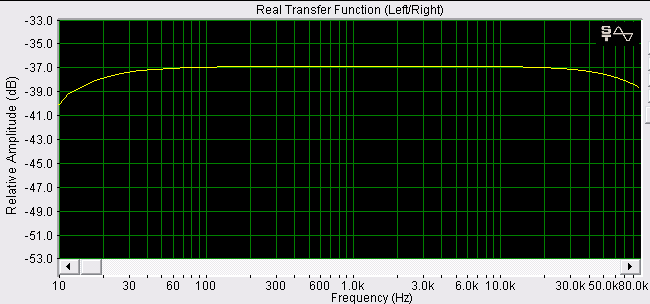
The following three graphs look at the analog section of the AVR 7300 using the CD input in stereo mode with no DSP processing. The input signal was 1 volt in all measurements, and the measurement was taken from one of the pre-outs.
Measuring THD+N at 1 kHz, the AVR 7300 yielded 0.02% which falls easily below Harman's specified 0.07%.

Raising the frequency to 10 kHz yielded a value of 0.02%, almost unchanged from the previous measurement.
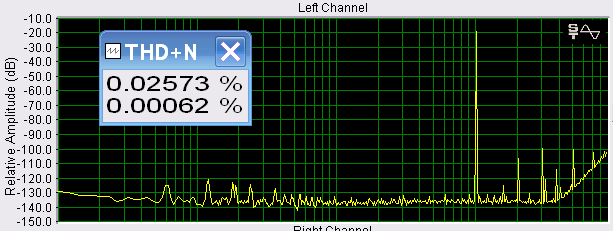
IMD measured using 10 kHz and 11 kHz signals showed an extremely low 0.0004%.
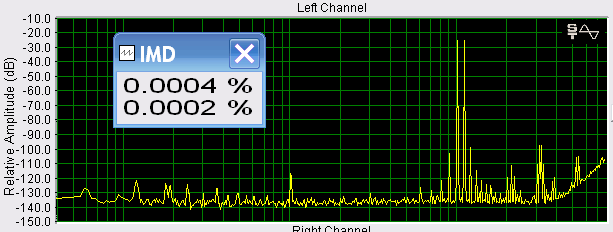
The next three graphs repeat the same measurement, but use the speaker level outputs driving an 8 ohm load. The measurement increase just slightly over the values achieved from the pre-out, but still stay far below the Harman specifications.
1 kHz input resulted in a THD+N of 0.02%.
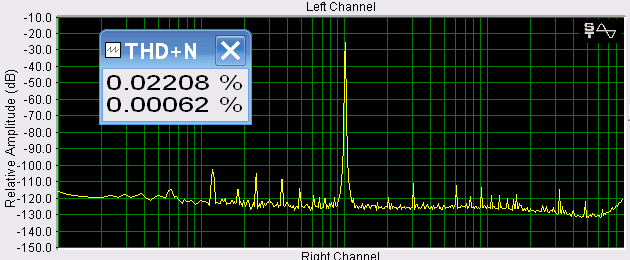
At 10 kHz input, the THD+N was 0.03%.

10 kHz and 11 kHz input signals gave an IMD of 0.005%.
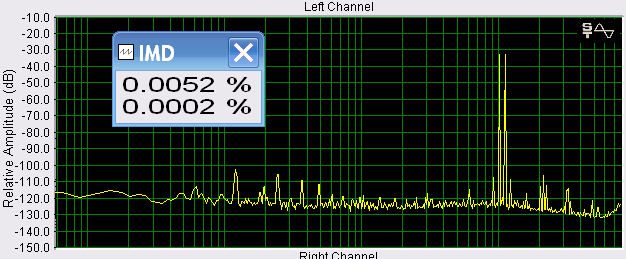
The next three graphs repeat the same three measurements again at 110 watt output into 8 Ohms. Again the measurements hardly change from those of the pre-out or the 1 watt signal. The amp will clearly deliver the fully rated specs if not a little more.
With 1 KHz input, the THD+N was 0.02%.

At 10 KHz, the THD+N was still only 0.03%.

Using 10 KHz and 11 KHz input signals, IMD was at 0.005%.

I believe this is an excellent receiver, but there are a couple of points I wanted to make before Ross states his conclusions. First off, I don't care for the large remote supplied with the AVR 7300 (two remotes are supplied, one for the main system and one for Zone 2). Initially, the buttons can be hard to find and are placed in a non-standard configuration making it unintuitive to use. Luckily, it lights up in the dark, otherwise it would be a real problem. The remote does have a nice programming interface for auto-detecting the IR codes of your components which should save you time not having to look up all those little codes at the back of the manual. The second small issue is that you must connect the receiver to a display to configure most of the settings. These are both small annoyances, but I point them out in hopes someone at Harman is listening.
Conclusions
The AVR 7300 delivers excellent sound quality, with ample power for most listening environments. It also includes Faroudja video processing, offering video capabilities not found in many other receivers. The AVR 7300 does lack the new Auto EQ found in some products out there, but is still a tremendous value at less than $2,400.
- Ross Jones -


